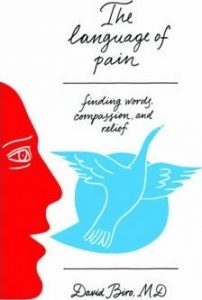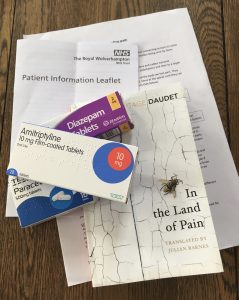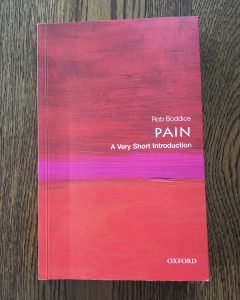Chronic pain is an invisible illness that affects 8 million adults in the UK and is often seen as a symptom of a disease and not a condition in its own right. It is a challenging experience for patients and their doctors.
It can be hard for patients to explain their experience of pain and for doctors to understand. Treatment is not straightforward and interventions can cause more problems and do not always relieve suffering.
There are many useful metaphors for helping to understand the suffering of chronic pain. This is one that is used by the Pain Management Team at The Walton Centre in Liverpool:

Pain can feel overwhelming and can make patients feel trapped. It is represented in this metaphor by the bottom pillow. The other pillows represent the secondary effects of chronic pain e.g. anxiety, loss of function, insomnia, weight gain, loneliness, loss of self esteem and fatigue. Sometimes it is very hard to do anything to reduce the pain itself, but changing the focus to managing the secondary effects of chronic pain can improve quality of life and sense of wellbeing.
pictures to prompt thought and discussion about chronic pain

Reproduced under Creative Commons license
Possibly the most well-recognised painting associated with chronic pain is Frida Kahlo’s ‘A Broken Column’. She painted this picture just after she had spinal surgery to correct the consequences of a life-changing traffic accident.
In what way does Khalo convey her pain and suffering in this picture?

Reproduced under Fairuse
This is another of Kahlo’s paintings.
Maybe she sees a similarity between her own struggle with pain and that of the deer’s constant struggle to survive being hunted? What do you think?

Reproduced under Creative Commons licence
Charles Bell was a doctor who spent much of his life drawing with the aim of capturing the ‘expression of emotion related to illness and disease’. This is his representation of ‘pain’ published in his book ‘The anatomy and philosophy of expression as connected with the fine arts’ (London, 1844), p. 157.
What picture or image would you choose to represent chronic pain?

Deborah Padfield is an artist who suffers from chronic pain. After a conversation with her consultant, she decided to use her art to express how her pain felt to her doctors. This resulted in two projects INPUT and Face2face in which she worked with chronic pain patients to create visual representations of how their pain felt and what it meant to them. With their permission and support, these photographic images were made into ‘pain cards’ to be used by doctors in pain clinics to communicate with their chronic pain patients. Read more about this in the BMJ article ‘What does chronic pain look like?’
You can read more about her work in her book ‘Perceptions of Pain’ and website of the same name
books to prompt thought and discussion about chronic pain
Virginia Woolf lamented that ‘even a schoolgirl, when she falls in love, has Shakespeare and Keats to speak her mind for her; but let a sufferer try to describe a pain in his head to a doctor and language at once runs dry.’

The Language of Pain David Biro 2010 published by W. W. Norton Company
Pain is invisible. Doctors, friends, family begin to question the legitimacy of your pain when that pain doesn’t go away. In his book, The Language of Pain, David Biro suggests that part of what makes suffering painful is the incommunicability of pain: the inability to talk about pain to the people around you is what makes pain most painful.

How Much Pain Is Too Much Pain Hilary Mantel (available to read online)
This short story discusses the author’s experience of chronic pain.
This is an except from her story.
‘A few years ago, when the pattern of pain had become more insistent and less easily managed, I was referred to a neurologist. My hour with him stays with me as a shining example of good practice. His history-taking was so structured, so searching, so thorough that I felt that, for the first time my pain was being listened to. The consultation was itself therapeutic.’

The Land of Pain Alphonse Daudet This edition published by Vintage in 2018
Alphonse Daudet, author and friend of Flaubert, Zola, Charcot and other famous French pioneers suffered from syphilis. In the late 19thCentury this was incurable and caused a life of pain. Daudet kept a journal about his intractable pain. After Daudet’s death, it was published in 1931 by his wife under the title ‘In the Land of Pain’. The edition I read was published by Vintage in 2002 and was translated by Julian Barnes. The edition contains his introduction and notes. Daudet’s journal contains some vivid descriptions of life in pain and is still relevant today.
These are some of Daudet’s descriptions of pain:
‘Pain has a life of it’s own’ The ingenious efforts a disease makes in order to survive’.
‘My poor carcass is hollowed out, voided by anaemia. Pain echoes through it as a voice echoes in a house without furniture or curtains. There are days, long days, when the only part of me that’s alive is my pain.’
‘It’s bearable, and yet I cannot bear it.’
‘Armour is exactly what it feels like, a hoop of steel cruelly crushing my lower back. Hot coals, stabs of pain sharp as needles.’
‘Pain is always new to the sufferer, but it loses its originality for those around him. Everyone will get used to it except me.’
Talking about morphine-
‘Each injection stops the pain for three or four hours. Then come ‘the wasps’, the stinging and stabbing here, there and everywhere- followed by the Pain, that cruel guest.’

Pain (A very short introduction) Rob Boddice 2017 published by OUP
This little book places the story of pain in historical context and explores the pain experience as it relates to social class and culture. It’s a great introduction to thinking more about chronic pain.
poems to prompt thought and discussion about chronic pain
Can you find a poem to help you understand chronic pain.
Can you write a poem about what it feels like to manage a patient in pain?
These are my poems about my experience of living with chronic pain.
page published August 2019
updated February 2022
